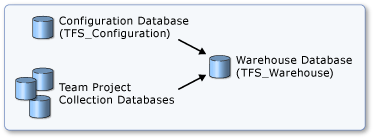Create and manage Reporting Services reports
TFS 2017 | TFS 2015 | TFS 2013
If you added SQL Server Reporting Services at installation, then your on-premises Azure DevOps deployment is configured with:
- A data warehouse
- SQL Server Analysis Services cube
- Reporting Services Reports
If you didn't add these services previously and want to add them now, see Add a report server to your deployment.
You can create or customize your own Reporting Services reports that support the following scenarios:
- Allow users to update the report without granting them read access to the databases.
- Share your reports in Team Explorer under the Reports folder.
- Support subscriptions to reports that can be sent daily over email.
- Manage the properties of your reports so that they return results faster and use fewer server resources.
- Use Transact-SQL queries to retrieve the data for your reports.
To learn more, see the following articles:
Creating Reports for Team Foundation Server 2010 describes how to create reports that you can view by using Report Manager. (There are only minor schema changes introduced for the TFS 2015 relational warehouse since TFS 2010).
Customizing Reports for Team Foundation Server 2010 describes how to customize the default reports for Reporting Services that are provided with each process template. These reports use queries that are written in either SQL or Multidimensional Expressions (MDX). (There are only minor schema changes introduced for the TFS 2015 cube since TFS 2010).
Table reference for the relational warehouse database. The warehouse contains data about
- Builds
- Source code
- Test results and code coverage
- Work items such as tasks and bugs.
Data in the warehouse is collected from the operational stores and organized in a set of tables, views, and table-valued functions from which you can design reports. You can explore relationships between the integrated data sets by directly querying and creating reports from data that is stored in the relational warehouse database.

Perspectives and measure groups provided in the Analysis Services cube. The Team System cube provides all metrics that are defined for all measure groups. By using the Analysis Services cube for TFS, you can generate reports of aggregated information about the data that is stored in team project collections. You can easily use this data to create PivotTable and PivotChart reports in Microsoft Excel.

Reportable fields reference. All data captured for work items is written to the WIT data store, but only select data is written to the Analysis Services data warehouse. The reportable attribute assigned to each work item field determines whether data is written to only the relational warehouse database or to both the relational warehouse and the OLAP cube. Reportable fields have their reportable attribute set to detail, dimension, or measure.
Tools for creating reports
You can access both the relational data warehouse and the Analysis Services cube to create highly customized reports by using these authoring tools.
- Report Builder is an intuitive environment for authoring reports. This application is optimized for Microsoft Office so that business users can work in that familiar environment. You can use Report Builder to work with data, define a layout, preview a report, and publish a report to a report server or a SharePoint site. This application includes a wizard for creating tables or charts, query builders, and an expression editor. It also supports the advanced reporting features in SQL Server Reporting Services.
You can download Report Builder for free from the following pages on the Microsoft web site:
Report Designer is a graphical interface for creating full-featured Reporting Services reports. After your report is finished, you have access to the full functionality for managing Reporting Services reports. To use Report Designer, you must know how to connect to and query a data source. You don't have to know Report Definition Language (RDL).
To use Report Designer, you must have Visual Studio and SQL Server Business Intelligence Development Studio.
To learn more about how to work with the authoring tool, see these articles:
Q & A
Q: How do I view and organize default Reporting Services reports?
A: See Reporting Services Reports.
Q: How do I upload a report?
A: See Upload reports.
Q: How do I manage report properties?
A: After you create and publish reports, you can use Report Manager to view, organize, and configure those reports. By using Report Manager, you can group related reports in folders, adjust parameters and data sources, and schedule automated reports. See View, organize, and configure reports using Report Manager.